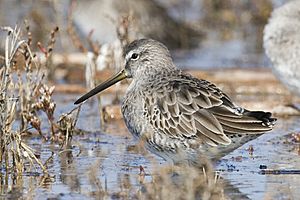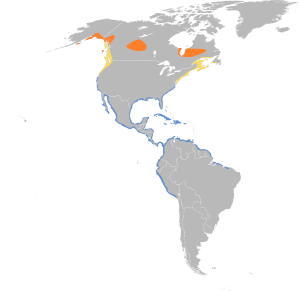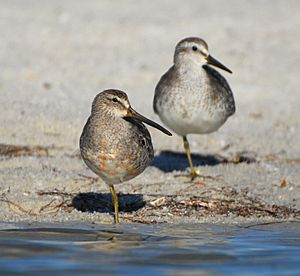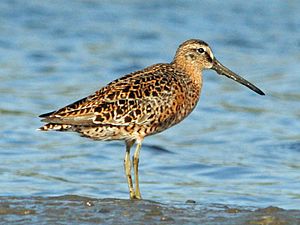Short-billed dowitcher facts for kids
Quick facts for kids Short-billed dowitcher |
|
|---|---|
 |
|
| Conservation status | |
| Scientific classification | |
 |
|
| Synonyms | |
|

The short-billed dowitcher (Limnodromus griseus) is a medium-sized shorebird. It has a stocky body and a long bill. This bird is related to the long-billed dowitcher. Both belong to the Scolopacidae family.
The name Limnodromus comes from Ancient Greek words. Limne means "marsh," and dromos means "racer." The word griseus is Medieval Latin for "grey." The English name "dowitcher" comes from the Iroquois language. It was first used in 1841.
This bird lives in North America, Central America, the Caribbean, and northern South America. It travels long distances, moving away from its breeding areas when snow covers the ground. Short-billed dowitchers like different places to live. These include tundra in the north and ponds and mudflats in the south. They eat small creatures by quickly pushing their bills into the mud.
The short-billed dowitcher looks very much like the long-billed dowitcher. Until 1950, people thought they were the same species. Even today, it can be hard to tell them apart. It is especially difficult to identify young or wintering birds. Their body shapes are only slightly different. The easiest way to tell them apart is by their calls. Their names can be confusing because their bill lengths often overlap. Only a few birds can be identified just by their bill length.
Contents
What the Short-billed Dowitcher Looks Like
Adult short-billed dowitchers have dark brown feathers on their backs. Their undersides are reddish. Their tails have a pattern of black and white bars. Their legs are yellowish.
There are three types, or subspecies, of this bird. They each have small differences in how they look:
- L. g. griseus has a white belly and barred sides.
- L. g. hendersoni has a reddish belly and spotted sides.
- L. g. caurinus has a white belly with many bars on its sides. It also has a lot of spots on its chest.
None of these subspecies have both a reddish belly and barred sides in their breeding feathers. This is a key difference from the long-billed dowitcher. In winter, their feathers are mostly grey. These birds can be about 23 to 32 centimeters (9 to 13 inches) long. Their wingspan can be 46 to 56 centimeters (18 to 22 inches). They weigh about 73 to 155 grams (2.6 to 5.5 ounces).
The sound this bird makes is softer than the long-billed dowitcher's call. This call helps people identify them, especially when their feathers are hard to tell apart.
Where They Live and How They Reproduce
Short-billed dowitchers breed in northern North America. Their breeding places include bogs, tidal marshes, mudflats, or clearings in forests. These areas are usually south of the tree line.
- L. g. griseus breeds in northern Quebec.
- L. g. hendersoni breeds in north central Canada.
- L. g. caurinus breeds in southern Alaska and southern Yukon.
These birds build their nests on the ground, often near water. Their nests are shallow dips in clumps of grass or moss. They line the nests with fine grasses, small twigs, and leaves. They lay four eggs, but sometimes three. The eggs are olive-buff to brown. Both the male and female birds take turns sitting on the eggs. This incubation lasts for 21 days.
The young birds, called chicks, are covered in soft downy feathers. They leave the nest soon after they hatch. We don't know much about how the parents share their duties. However, it is thought that the female leaves, and the male takes care of the chicks. The chicks find all their own food.
These birds migrate to warmer places for winter. They fly to the southern United States and as far south as Brazil. During migration, you are more likely to see this bird near ocean coasts than the long-billed dowitcher. The short-billed dowitcher is very rarely seen in western Europe.
What They Eat
Short-billed dowitchers find their food by probing in shallow water or wet mud. They mostly eat insects, mollusks, crustaceans, and marine worms. They also eat some plant material.
See also
 In Spanish: Becasina piquicorta para niños
In Spanish: Becasina piquicorta para niños



